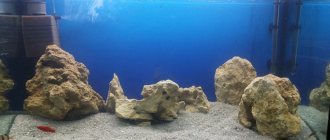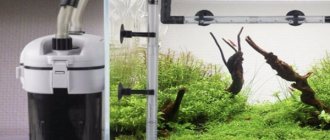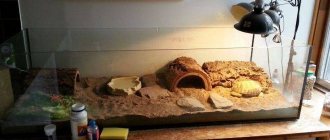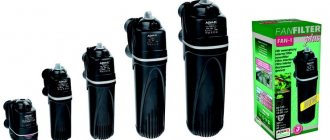NH4, NO2, NO3 are compounds that are toxic to aquarium water, causing the death of fish and the growth of algae. When the aquarium biobalance is stabilized, an increase in the concentration of nitrogenous compounds is excluded, but inexperienced aquarists often allow the problem to occur due to improper maintenance of the tank and care of the fish. Zeolite for aquariums is an effective water purifier from excess ammonium. However, if used incorrectly, zeolite can bring not only benefits, but also harm.
What is zeolite
Zeolite is a mineral belonging to the group of aluminosilicates. There are several types of zeolite, the most common being chabazite, stilbite, natrolite and clinoptilolite .
Externally, the mineral looks like a crystal with a pearlescent color. The action of zeolite is the selective release of harmful substances in water and their subsequent absorption. It is also a mineral responsible for cation exchange. Zeolite is a mineral belonging to the group of aluminosilicates
Important ! It is believed that the best absorbent for aquarium water is clipnoptilolite. It can be used to improve water quality through absorption. Main properties and advantages
Zeolite is introduced into the aquarium as an adsorbent. But potassium rather than sodium species are suitable for these purposes. After all, with the help of potassium zeolites, all organic residues and waste products of shellfish and fish are removed from the tank. Sodium species cause significant harm and worsen water parameters.
The benefits of the potassium mineral are quite large. With its help, ideal conditions for capricious phenotypes are created in the container. The likelihood of liquid blooming is reduced.
Price
The quality of foreign and domestic drugs is almost the same, but the price differs significantly due to logistical issues. How much a mineral supplement costs depends mainly on the brand. The most popular drug in a 1 liter container from the domestic manufacturer Prime will cost 180 rubles, 5 liters - 530 rubles.
Zeolite is an effective and safe method for improving the quality of aquarium water. The main thing is that you need to use it correctly, observing the dosage, so as not to upset the ratio of the nitrogen component and beneficial bacteria.
What is zeolite
One of the newest and best techniques for improving the quality and purification of aquarium water is natural zeolite. The mineral acts as an inexpensive, reliable and safe purifier of natural origin, which is able to cope with severe pollution in artificial reservoirs. Zeolite for aquariums is especially in great demand if the water contains a high concentration of ions and nitrates, which are formed due to the functioning of fish and other aquarium inhabitants. It should be noted that with a high content of ions and nitrates, harmful algae and bacteria begin to actively develop in the aquarium, and the water loses transparency.
Zeolites are a group of minerals that can filter liquids, thus promoting ion exchange. All zeolites can be divided into two main types:
- sodium - used in industrial oil and gas areas;
- potassium - a group that aquarists are happy to use for the safe purification of water in artificial reservoirs.
Dosage
If the concentration of ammonium in 1 liter of water exceeds 1 mg, then purification is required. Take 1 g of zeolite per 1 liter of water. The dosage is adjusted taking into account the intensity of contamination. If the contamination of the aquarium is not severe, then the concentration of the drug is reduced.
There is no need to fear that the mineral will draw out all the beneficial substances from the water. An overdose is impossible if the mineral component does not exceed 30% of the volume of the aquarium substrate. The capacity of zeolite is limited; it is capable of accumulating a certain number of ions and retains them. Uncaptured ions remain in the water and are absorbed only when a cationic “spot” is released.
Zeolite - what is it?
Almost all experienced aquarists, when dissatisfied with the quality of the water, begin to look for and apply new filtration and absorption methods. One of the most innovative techniques is water filtration using a natural material – zeolite. It acts as an inexpensive but very reliable natural purifier that can deal with water contamination in ponds or aquariums. It is especially popular in cases where the content of ammonium ions and nitrates in the water is greatly increased, which are released during the life of fish and lead to “blooming” and waterlogging of the aquarium.
What is this useful mineral? Zeolites are a fairly large group of minerals that are distinguished by their ability to pass water through themselves, promoting its ion exchange. It is known that there are about 48 types of zeolites in nature, and in addition - 150 synthesized artificial minerals. The most popular of them are: chabazite, laumontite, natrolite, thomsonite.
All zeolites are divided into two large groups: sodium and potassium minerals. Sodium zeolite is used for industrial purification of liquids or gases; it cannot be used in aquarium farming.
But the second group - potassium minerals - is successfully used to purify water even in aquariums with plants. Usually this mineral is sold in pet stores in specialized packaging of 400 grams. This amount is quite enough to provide the fish with comfortable living conditions.
Natural filter-adsorbent zeolite
Zeolite is formed as a result of exposure to high temperatures and significant pressure. The formation process is very long - several million years. The deposited layer of volcanic ash was subject to physical and chemical changes.
Zeolite is characterized by a unique structure. It looks like a three-dimensional lattice. The composition includes silicic acid tetrahedra (SiO4)4-, interconnected oxygen atoms. In this case, in place of some silicon atoms there are aluminum atoms (AlO4)5-. Thanks to this, a special spatial structure is formed, which has a significant number of pores. When connected to each other, they create small pores where metal cations or H2O molecules are located. These pores occupy about 24-32% of the total volume of the mineral. Table 1 shows the general chemical composition of zeolites.
Table 1. General chemical composition of zeolites
| Chemical element | Percentage of the mineral | Chemical element | Percentage of the mineral |
| SiO | 69.0-74.0% | CaO | 1.7-3.3% |
| TiO | 0.08-0.16% | MgO | 0.4-1.7% |
| Al2O3 | 11.4-14.0% | K2O | 4.0-5.5% |
| Fe2O3 | 0.6-1.8% | Na2O | 0.4-0.9% |
| MnO | 0.02-0.05% | H2O | <10% |
Natural zeolites are found in green or light gray. They are dense, fine-grained crumbs, the fraction of which is 0.5-100.0 mm.
Properties of zeolites
The mineral is distinguished by its adsorbing properties. Its internal structure has highly mobile voids, cavities or pores, due to which ion exchange occurs. Sorbent zeolite
has the following properties:
- Adsorption - it is able to absorb and return various substances.
- Ion exchange – it can exchange cations.
- Catalytic - a mineral capable of accelerating chemical reactions.
Zeolites have a certain pore size, and therefore can absorb and transmit molecules of other substances selectively. This phenomenon is called the molecular sieve effect.
According to VNIIgeolnerud and VostSibNIIGTIMNA, these minerals are included in the first group of natural materials according to heat and acid resistance. In other words, zeolite is a highly resistant rock to high temperatures and various acids. They have good regenerative abilities. Able to withstand temperatures up to 600℃. They are not afraid of aggressive environments. After their exposure, no visible traces of destruction remain. Zeolites are a non-toxic mineral with no mutagenic effect. Application is not limited in various areas of economic activity.
What does oxygen depend on?
There are several factors that can affect the amount of oxygen. This is the temperature, the presence of vegetation and living organisms in Temperature
If the temperature of the water decreases, then the concentration of oxygen in it also decreases. Raising the temperature to a level higher than normal provokes an acceleration of metabolic processes in aquarium inhabitants. This leads to an increase in their need for oxygen. Accordingly, a decrease in temperature leads to the opposite consequences. You can stabilize the situation with help
Aquarium water temperature
Vegetation
The peculiarity of plants lies in their ability to produce oxygen. But here, too, not everything is so simple. It is necessary to understand that at night, using this oxygen, they participate in the process of hydrocarbon production. It turns out that fish breathe oxygen produced by aquafauna
Oxygen concentration can depend not only on plants, but also on living organisms inhabiting the aquarium. First of all, we are talking about snails and other small creatures. The number of these creatures directly affects the amount of organic waste and, accordingly, bacteria, which also consume oxygen. Therefore, aquarium fauna plays an important role in the process of oxygen formation.
Wastewater treatment
Zeolite is a modern solution for purifying wastewater from various toxic substances. It can remove oil, amines, petroleum products and other organic compounds in wastewater. Wastewater treatment with zeolite
especially popular in Japan. Here, to preserve fishing grounds, up to 4800 tons of zeolite are consumed. It is scattered in the coastal zone during fish spawning.
Zeolite allows you to get rid of ammonia nitrogen, which is extremely toxic when its concentration is exceeded. It has a detrimental effect on nature. It can destroy fish and all living things. Therefore, the use of rock in Japan is completely justified.
A new word in ionitoponics?
Zion is widely sold as a fertilizer, although in fact it is a means of ionithoponics - an ion exchange substrate for plants . Ionitoponics is a relatively recently emerged area of hydroponics, i.e. growing plants not in the ground, but in an artificial environment, liquid nutrient or porous, chemically and biologically neutral. In the latter case, the soil serves the plants only for anchorage. Mineral nutritional elements are introduced into the substrate in the form of solutions.
Ionite substrates for plants Zion (universal, for greens, for vegetables, for flowers)
The Achilles heel of hydroponics is the nutrient solutions themselves. Plant nutrition in our time has been thoroughly studied, and there are no problems with the formulation of fertilizing: complete complex fertilizers with microelements for any crop are available for sale in abundance. But! Nutrient solutions can produce sediment (suspension) that clogs the system. Their electrical conductivity is not zero, which can cause electrocorrosion of metal parts. And cleaning and repairing hydroponic systems is labor-intensive and expensive. In addition, an accidental overdose of nutrition causes the accumulation of undesirable substances in the fruits and chemical burns of plants, and an undersupply has a sharp effect on the size of the harvest.
Ion exchange
In ionithoponics, plant nutrition is introduced in advance into a substrate of ion exchangers - substances capable of ion exchange. Anyone who has a kitchen filter for purifying and softening water (Rucheek, Spring, Geyser, Aquaphor, etc.) has encountered them. The operating principle of ion exchangers is shown in Fig. below: in the operating cycle, the ion exchanger absorbs hardness ions from water, releasing Na + in return, and when the ion exchanger is regenerated, the reverse process occurs.
Ion exchangers came into everyday life from industry and special applications: ion exchange agents are used for purifying and desalting water, isolating and separating rare metals, etc. Supply kits for lifeboats include ionite seawater desalinators, as do individual emergency kits for pilots flying over the sea .
Ionitoponics
One of Murphy's laws says: if you can't get it right, do the opposite. Ionithoponics is a striking example of this: a special ion exchanger is “tuned” to release plant nutrients in exchange for the products of plant metabolism released by their roots. Overdose, underfeeding and chemical burns are excluded - plants receive nutrition as if under the supervision of an experienced nutritionist, but without the need for a highly paid human specialist. Ion exchange occurs in a humid environment when watering with clean water: the likelihood of clogging and breakdown of the system is minimal. Disadvantages (and serious ones), because of which ionithoponics has not replaced conventional hydroponics:
- It is impossible to quickly regulate the nutrition of plants: their menu will only contain what was included in the ion exchanger during its manufacture;
- There is no universal ion exchange substrate: each is suitable only for plants of one species or a group of closely related species;
- In one substrate it is difficult, or even impossible, to combine all the nutrients necessary for a given plant so that the ion exchange rate of all is optimal;
- The ion exchange nutrient substrate is disposable: it cannot be regenerated, unlike ion exchangers for water purification;
- The production of ion exchange substrate is difficult, and the finished product is expensive.
Note : about ionitoponics, see also the video:
Video: why do you need ionoponics?
Helena - aquarium predator
Helena snail
Helena snail
the storm of all coils, physical and melania
Very surprising and interesting representatives of mollusks in our aquariums are Helena snails ( Anentome Helena ). These are quite beautiful and attractive inhabitants of the aquarium. These yellow-striped representatives of the reservoirs of Thailand, Indonesia and Southeast Asia are unpretentious in keeping, feeding and breeding. It can be said about them, like many aquarium mollusks, that they do not require personal care.
The size of Helen snails is 0.5 - 1 cm. The body of the mollusk is elongated, the head and legs have a trunk-like shape
In addition to their decorative properties, Helena snails have a very interesting feature - they are predators and feed on animals (protein foods). Unlike many other freshwater snails, they do not eat plant organic matter.
This amazing property of Helen is perfectly used in the fight against such small snails as: melania, coils, physa , acrolux. The Helens attack and destroy them. Thus, we can naturally, biologically control the number of small snails that breed like rabbits. Yes, this process is not as fast as using chemicals against snails, but it is natural. In addition, almost all snail repellents contain copper, which is dangerous - poisonous to fish and disrupts the biobalance of the aquarium. In addition, a sudden death of snails from chemicals leads to the same sharp pollution of the aquarium, the growth of dead organic matter, ammonia, nitrites and nitrates . After using such preparations, you need to carefully clean (siphon) the aquarium, filter the water well, and it is advisable to use aquarium charcoal and zeolite.
The water in the aquarium is darkening
Aquarium 35 liters (water), launched 2 months ago. Fish: 5 small barbs, 2 parrots + 5 fry (1 week), 1 ancistrus (4 cm), 5 helen snails. Feeding once a day, either tetra procolor, or unknown flakes (the seller of the fish sprinkled it), all food is dry, and is eaten completely. Filter Tetra IN 400 (24 hours a day) Heater. Compressor (works around the clock, at 50%). Temperature 25. udeco soil 1-2mm, layer 5 cm, in the soil below there are 5 tablets of fertilizers for plants. I don’t know the names of the plants - in the photo. Light 1 regular energy-saving lamp 14 W, 12 hours a day. Changes 15-20% 2 times a week (with a point siphon of soil with a thin tube in places where guano accumulates). Nitrates 25, did not do any other tests. Distance from the window 4 meters, shady side.
Question: The water in the aquarium is a little dark (although it looks very clear). This is fine? The other day we left for 3 days, the fry of the parrots had just hatched, and the barbs had to be moved out. The lights were turned off during absence. When we arrived, the water in the aquarium was very clean and light (but a gray coating appeared on the stones, plants and driftwood). The barbs were returned back, the lights were turned on again - after a couple of days the water began to darken again, this is clearly visible in the photo when there are two aquariums nearby (the second is 17 liters without fish, the temperature of the lamps is the same). In large quantities, visually the water has a “warmer” tint (especially noticeable when you pour it into the toilet after changing it).
Design and principle of operation
Internal aqua cleaners have a fairly simple design. Each of them is a cylindrical body with slots for drawing in water, to which a small pump is attached.
Inside the housing is one or more filter media. In its simplest form, this material is foam rubber (elastic polyurethane foam).
Water, passing under pressure through the foam cells, gets rid of mechanical impurities and goes back into the aquarium. Colonies of saprophytes (microorganisms accumulating in foam cells) perform biological purification of aqua, turning decomposed organic matter into inorganic substances.
In appearance, the device resembles a glass. This is what owners of ornamental fish often call it.
How long should a filter run in an aquarium?
The aquarium filter must work around the clock. Colonies of nitrifying bacteria grow on the surface of the filter elements, which contribute to the correct biological balance inside the aquarium.
Without oxygen, bacteria die. Therefore, only short-term shutdowns are allowed - no more than 1-2 hours (for example, for maintenance).
Otherwise, dead colonies of bacteria will be restored over a long period of time. The worst outcome is when the dead colonies of bacteria inside the filter begin to decompose, releasing hydrogen sulfide, methane and other toxic compounds that are harmful to fish.
Sources
- Regulatory documents of educational institution No. 5 2015 / Absent. - M.: MCFR, 2015. - 946 p.
- Rules for recreational fishing in reservoirs of fishery importance in the Tver region. Reference publication / Team of authors. - M.: Publishing solutions, 2015. - 206 p.
- Collection of Law and Economics in the Modern World. Issue V / Collection of articles. — M.: AUTHOR, 2021. — 296 p.
- Modern problems of implementation of land and environmental law / Team of authors. - Moscow: Nauka, 1977. - 787 p.
- Prygunov, S. E. Occupational safety. General provisions (collection of normative acts) / S.E. Prygunov. - M.: Eksmo, 2015. - 800 p.











